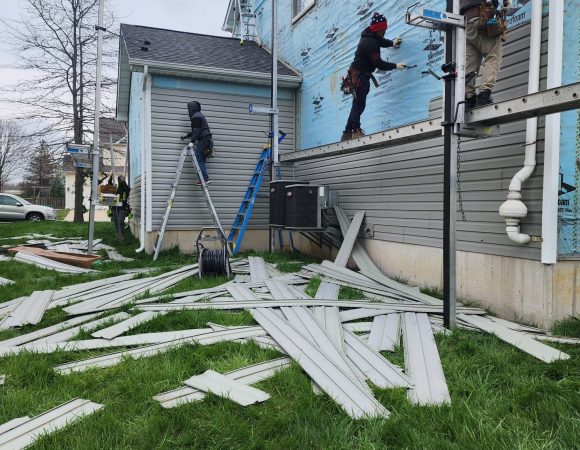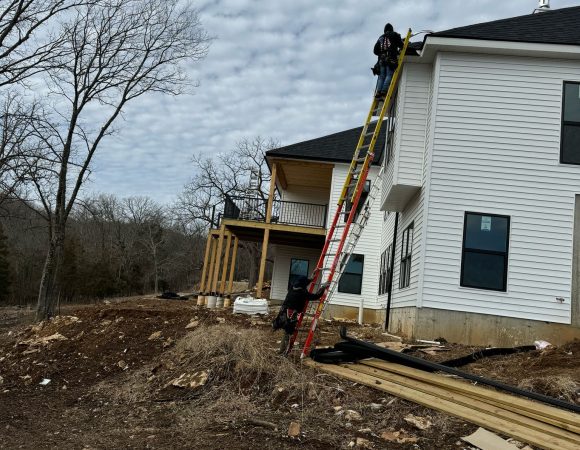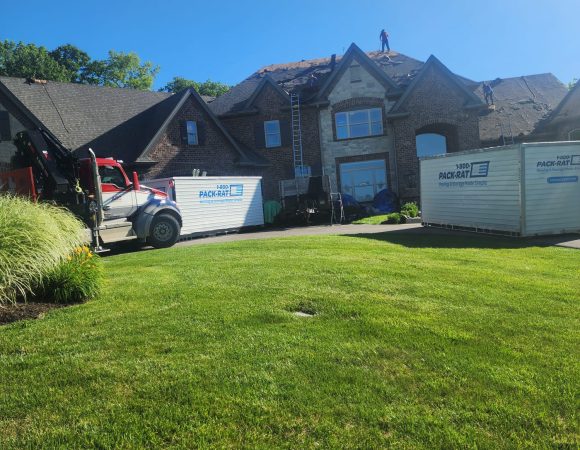Here’s a step-by-step guide on how to handle storm damage and file a successful insurance claim.
Step 1: Assess the Damage Immediately
After the storm has passed and it’s safe to go outside, perform a visual inspection of your roof. Look for visible signs of damage such as:
Missing or damaged shingles
Hail dents
Cracks or holes
Water stains on the ceiling (interior leaks)
If you notice any of these signs, it’s time to call a professional roofing contractor for a more detailed inspection. S.T.L BEST ROOFING offers free roof inspections to identify any hidden damage.
Step 2: Document the Damage
Before any repairs are made, take detailed photos and videos of the damage. This documentation will be essential for your insurance claim. Make sure to capture:
Close-up images of damaged shingles or materials
Wide-angle shots showing the overall damage
Interior shots showing water damage or leaks
The more thorough your documentation, the better chance you have of receiving full compensation from your insurance provider.
Step 3: Contact Your Insurance Company
Reach out to your insurance company as soon as possible. Most policies have a limited time window for filing a claim after the storm, so don’t delay. During your call, be ready to:
Provide information about the storm date and damage details
Submit the photos and videos you’ve taken of the damage
Ask about the claim process, including deductibles and coverage limits
Step 4: Schedule an Insurance Adjuster’s Visit
After you file your claim, the insurance company will likely send an adjuster to inspect the damage. This adjuster will evaluate the extent of the roof damage and determine the compensation you’ll receive.
It’s crucial to have a roofing professional present during this inspection. A professional contractor like S.T.L BEST ROOFING can help ensure that all damage is properly documented and that you’re not undercompensated.
Step 5: Review the Claim Offer
Once the adjuster completes their inspection, you’ll receive an insurance claim offer. Review the offer carefully to ensure that all necessary repairs are covered. Be sure to check for:
Coverage limits: Does the offer cover the full scope of necessary repairs?
Depreciation: Some policies may reduce the payout based on depreciation.
Out-of-pocket costs: Make sure to clarify your deductible and any additional out-of-pocket costs.
If the offer seems insufficient or doesn’t fully cover the repairs, consider negotiating with the insurance company or asking for a second inspection.
Step 6: Hire a Reputable Roofing Contractor
Once your claim has been approved, it’s time to hire a professional roofing contractor to complete the repairs. Choose a contractor with a proven track record, proper licensing, and insurance. S.T.L BEST ROOFING has over 25 years of experience helping homeowners in St. Louis navigate insurance claims and restore their roofs to excellent condition.
Step 7: Complete the Repairs and Finalize the Claim
Once the repairs are done, your roofing contractor will provide you with a final invoice and receipt for the work completed. Submit these documents to your insurance provider for reimbursement (if applicable). Be sure to keep all records of your claim, repairs, and payment for your future reference.
Bonus Tips for a Successful Insurance Claim
File your claim promptly: Insurance companies often have time limits, so don’t wait.
Stay organized: Keep all documents and correspondence related to your claim.
Work with experienced professionals: The right roofing company can ensure the proper documentation and smooth communication with your insurance provider.


Why Gutter Maintenance Matters
Gutters are designed to channel rainwater away from your home’s roof and foundation, but if they are clogged or damaged, they can’t do their job properly. Clogged gutters can cause water to back up and overflow, leading to a variety of problems:
Roof Damage: Overflowing water can damage your roof’s fascia, shingles, and even lead to leaks.
Foundation Issues: Water that isn't properly directed away from your home can seep into the foundation, causing cracks and shifting.
Basement Flooding: Poorly maintained gutters can cause water to pool around the foundation, increasing the risk of basement flooding.
Landscape Damage: Overflowing gutters can damage your landscaping by washing away soil or plants.
To avoid these issues, regular gutter maintenance is essential. Below, we’ll go over the key steps to ensure your gutters are functioning properly.
Signs Your Gutters Need Attention
If you notice any of these signs, it’s time to take action and either clean or repair your gutters:
Overflowing Gutters: If your gutters overflow during a rainstorm, it’s a sign they are clogged with leaves or debris.
Sagging Gutters: Gutters that are pulling away from the roofline or sagging may indicate that they are weighed down by debris or damage.
Water Damage on Exterior Walls: Water stains, mold, or mildew on the exterior walls of your home can be a sign of clogged or damaged gutters.
Cracked or Missing Gutters: If your gutters are cracked or pieces are missing, they won’t be able to direct water properly.
How to Prevent Gutter Damage
Prevention is key when it comes to gutter maintenance. Here are some simple yet effective tips for keeping your gutters in great shape:
1. Clean Gutters Regularly
One of the most important steps in gutter maintenance is cleaning them out regularly. Leaves, twigs, dirt, and other debris can easily clog your gutters and prevent water from flowing freely. Cleaning your gutters at least twice a year—once in the spring and once in the fall—is recommended. In areas with a lot of trees, you may need to clean them more often.
2. Install Gutter Guards
Gutter guards or screens can be installed to help prevent debris from entering your gutters in the first place. These protective barriers allow water to flow freely while keeping leaves, pine needles, and other debris out. Gutter guards can save you time and money on frequent cleaning and reduce the risk of clogs.
3. Check for Proper Drainage
Ensure that the downspouts are positioned correctly and are free of clogs. Water should flow away from the foundation, not pool around it. Downspouts should direct water at least 3-4 feet away from the base of the home to prevent damage to the foundation.
4. Inspect Gutters for Damage
Regularly check your gutters for signs of damage, such as cracks, holes, or rust. If you notice any problems, have them repaired immediately to avoid further damage. A small crack can quickly turn into a much larger issue if left unchecked.
5. Trim Nearby Trees
Overhanging branches can drop leaves and other debris into your gutters. Regularly trim any trees or bushes near your roof to reduce the amount of debris that ends up in your gutters.
Gutter Repair and Replacement
If your gutters are beyond repair, replacement may be necessary. Signs that it’s time for gutter replacement include:
Severe rusting or corrosion
Large sections of gutters that are broken or missing
Continuous leaks despite repairs
At S.T.L BEST ROOFING, we offer comprehensive gutter installation, repair, and replacement services. Our team can assess your existing gutters and recommend the best solution for your home.
1. Asphalt Shingles – The Most Popular Choice
Best for: Budget-conscious homeowners, durability, and versatility
Asphalt shingles are the most common roofing material in the U.S., and for good reason. They are affordable, reliable, and come in a variety of styles and colors. Asphalt shingles are made from a fiberglass mat coated with asphalt and mineral granules, which makes them highly resistant to water and wind. Here’s why asphalt shingles are a great option:
Cost-effective: Asphalt shingles are typically less expensive than other materials, making them a great choice for homeowners on a budget.
Durability: They can last anywhere from 15 to 30 years, depending on the quality and type of shingle.
Variety of options: Available in a wide range of colors and styles to complement the architectural design of your home.
Low maintenance: Asphalt shingles require little maintenance, especially if installed correctly.
Keywords: asphalt shingles, affordable roofing, roofing materials, St. Louis roofing, roof replacement.
2. Metal Roofing – Durable and Energy-Efficient
Best for: Long-term investment, energy savings, and modern aesthetics
Metal roofing is growing in popularity due to its longevity, energy efficiency, and sleek look. Made from materials like steel, aluminum, or copper, metal roofs are durable and can withstand extreme weather conditions. Here’s why metal roofing is an excellent choice:
Longevity: Metal roofs can last 40-70 years or more with minimal maintenance.
Energy efficiency: Metal reflects the sun’s rays, reducing cooling costs in hot weather.
Weather-resistant: Metal roofs are ideal for harsh weather conditions, such as heavy rain, snow, and high winds.
Eco-friendly: Many metal roofing materials are made from recycled materials and are 100% recyclable at the end of their life.
Keywords: metal roofing, durable roofs, energy-efficient roofing, St. Louis roofing, metal roof installation.
3. Wood Shingles & Shakes – Classic Beauty with Natural Appeal
Best for: Homeowners seeking a traditional, rustic look
Wood shingles and shakes offer a natural, timeless aesthetic. They are typically made from cedar, redwood, or pine and provide an elegant, rustic look that’s perfect for certain architectural styles. However, wood roofs do require more maintenance than other options. Here’s why you might consider wood shingles:
Aesthetic appeal: Wood roofs provide a classic, natural look that complements rustic or traditional home designs.
Insulation: Wood naturally offers better insulation than other materials, keeping your home cooler in the summer and warmer in the winter.
Durability: With proper care, wood shingles can last up to 30 years.
Environmental benefits: Wood is a renewable resource, and many manufacturers use sustainable forestry practices.
Keywords: wood shingles, wood shakes, natural roofing materials, rustic roofing, St. Louis roofing.
4. Slate Roofing – A Luxury Choice for Long-Lasting Beauty
Best for: High-end homes, durability, and unique aesthetic
Slate roofing is one of the most durable and beautiful roofing materials available. Made from natural stone, slate roofs are incredibly long-lasting and offer a unique, elegant appearance. Slate is more expensive than other materials, but it’s a great choice for those looking for both beauty and durability:
Exceptional longevity: Slate roofs can last over 100 years when properly maintained.
Fire-resistant: Slate is naturally fire-resistant, offering extra protection for your home.
Aesthetic appeal: Slate provides a unique, high-end look and is available in various colors, including shades of gray, green, and purple.
Low maintenance: Slate requires minimal maintenance, as it’s highly resistant to the elements.
Keywords: slate roofing, luxury roofing, durable roofing materials, fire-resistant roofing, St. Louis roofing.
5. Tile Roofing – Timeless Design and Weather Resistance
Best for: Homes in warmer climates, Mediterranean or Spanish-style homes
Clay and concrete tile roofing are great options for homeowners who want a distinctive, durable roof. These materials are particularly popular for homes with a Mediterranean or Southwestern architectural style. Tile roofs are extremely durable and weather-resistant:
Durability: Tile roofs can last 50+ years with proper care.
Weather-resistant: Tile roofs are resistant to high winds, fire, and extreme temperatures.
Energy-efficient: They are naturally insulating, helping to keep your home cooler in hot weather.
Variety of designs: Tile roofs come in various shapes, colors, and styles, offering a custom look for your home.
Keywords: tile roofing, clay tile roofs, concrete tile roofs, Mediterranean roofing, durable roofing materials, St. Louis roofing.


© 2025 Copyright All rights reserved by stlbestroofing.